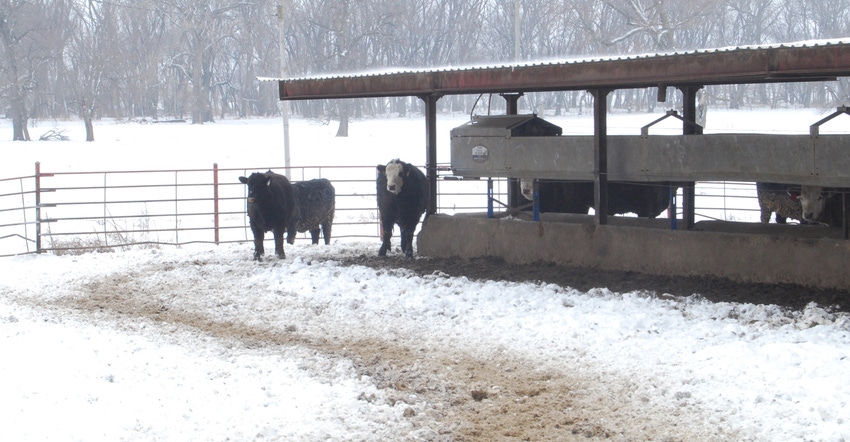February 18, 2019

Relative weights are a big factor, but not the only factor, driving feeder cattle price relationships. Prices per hundredweight normally decrease as cattle weights increase.
Not only do prices vary across cattle weights, but the magnitude of price differences, or amount of price adjustment, depends on the weight of cattle. This price differential, commonly known as a price slide, reflects what it costs to add weight to an animal. Because costs of gain are generally lower than the price of cattle in dollars per hundredweight, lighter-weight cattle have higher prices than heavier weight cattle, which creates the price slide.
A compact way to present feeder cattle market information is a graph of prices by weight for a specific class of feeder cattle, for a specific location and time, or an average across locations and time. The graph below shows the simple average of weekly 2018 prices for different weights of Iowa feeder steers.

How you can use price slides
Producers can use price slides in several ways. The most common is to adjust the price of forward-contracted cattle if actual weight differs from a specified base weight. Price slides are also useful for evaluating price changes for weight gain, which have implications for many management and marketing decisions, such as creep-feeding of calves, rate of gain to pursue in backgrounding programs, length of grazing season, and timing of buy-sell decisions.
The amount of price adjustment not only differs by weight, but also varies for steers and heifers and has a seasonal component. Market forces also impact the magnitude of the weight-price adjustment. These factors include corn prices, fed cattle prices, variability in the input and output prices, and recent cattle feeding margins.
Most existing research on price-weight relationships focuses on beef breeds. Research at Iowa State University examined eight years of auction data in Wisconsin. Researchers sought to determine the impact of these factors on feeder cattle price slides for both beef and dairy breeds within the 300- to 900-pound range.
One objective was to attempt to improve understanding of feeder cattle price relationships within dairy breeds. The Wisconsin feeder cattle auction market is an ideal market to study because of sizable volumes of both Holstein and beef breed transactions at feeder cattle auctions.
According to an Iowa Beef Center 2014 survey of Iowa feedlot operators, 91% of the cattle they typically place on feed are beef breeds, 8% are dairy and 1% dairy-beef crossbreds. Still, the general feeder cattle price relationships identified for Wisconsin in this study are likely to be similar in Iowa.
Multiple factors determine price
Simply looking at summary statistics from recent auction sales may not be sufficient given the existence of multiple interaction effects at play in determining feeder cattle prices. This study uses more of a statistical-based approach versus a traditional rule-of-thumb approach for developing projections.
The number of head on the auction block impacts bids. Larger lots tend to bring higher prices, but the premium shrinks as number of cattle in the lot rises. In this study, the optimal lot size was 44 head for beef breeds and 171 head for Holsteins. Don’t focus on those numbers. The key point is buyers of both beef and Holstein feeders are willing to pay premiums for larger lot sizes, but at a decreasing rate.
It is common to think of heifer calves being priced $10 to $15 per cwt back of the steer price. We find that for beef feeders the price difference is highest for calves weighing 500 to 600 pounds and lowest for the heaviest feeders. The premium for Holstein steers over heifers is highest between 400 and 500 pounds, and then it drops fairly rapidly at heavier weights.
Profit prospects impact slide
Price slides increase notably when corn prices decline and when expected fed cattle prices increase. When recent cattle feeding margins have been positive, price discounts for heavier-weight cattle tend to be lower relative to lighter-weight cattle.
Seasonality of cattle feeding performance and supply-and-demand of different weight cattle contribute to seasonal variation in price slides. Variability in fed cattle and corn prices impact price slides, but the impacts are generally much less than other factors considered in this study.
Many of the market factors examined were found to have different impacts on beef and Holstein feeder cattle price slides. A large price discount for dairy feeders relative to beef feeders has been documented previously, but we show that the discount decreases at an increasing rate as weight increases.
Beef feeders weighing less than 700 pounds received a premium in excess of $35 per cwt compared to Holsteins, with the premium on heifers being larger than steers. For cattle weighing greater than 700 pounds the premium on beef steers ($35 down to $22 per cwt by 900 pounds) was greater than for heifers.
For Holstein price slides, at very high corn prices, heavier-weight feeders bring premiums relative to lighter-weight feeders, and at very low live cattle prices heavier feeders essentially receive the same price as lighter feeders. Holsteins also show less seasonal variation in price slides as compared to beef breeds.
Although market participants cannot affect the forces that drive the cattle market, understanding how varying market conditions affect price slides can aid in management and marketing decisions.
Note: In addition to Lee Schulz, Brenda Boetel, a professor of agricultural economics at the University of Wisconsin-River Falls, and Kevin Dhuyvetter, a cattle technical consultant with Elanco Animal Health, also co-authored the study. Go online to read Price-Weight Relationships for Feeder Cattle: An Updated Dairy-Beef Assessment.
Schulz is the ISU Extension livestock economist. Contact him at [email protected].
About the Author(s)
You May Also Like






